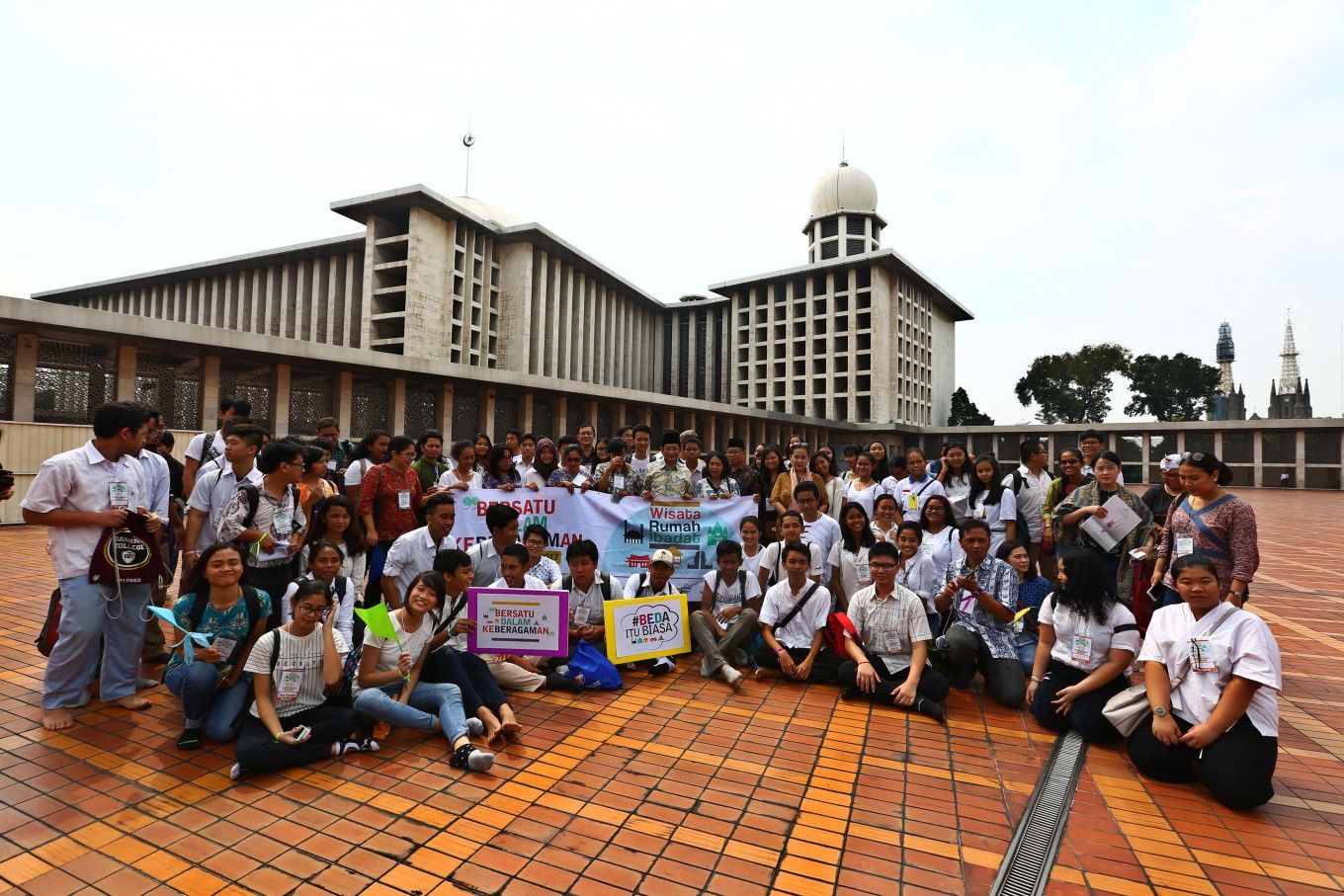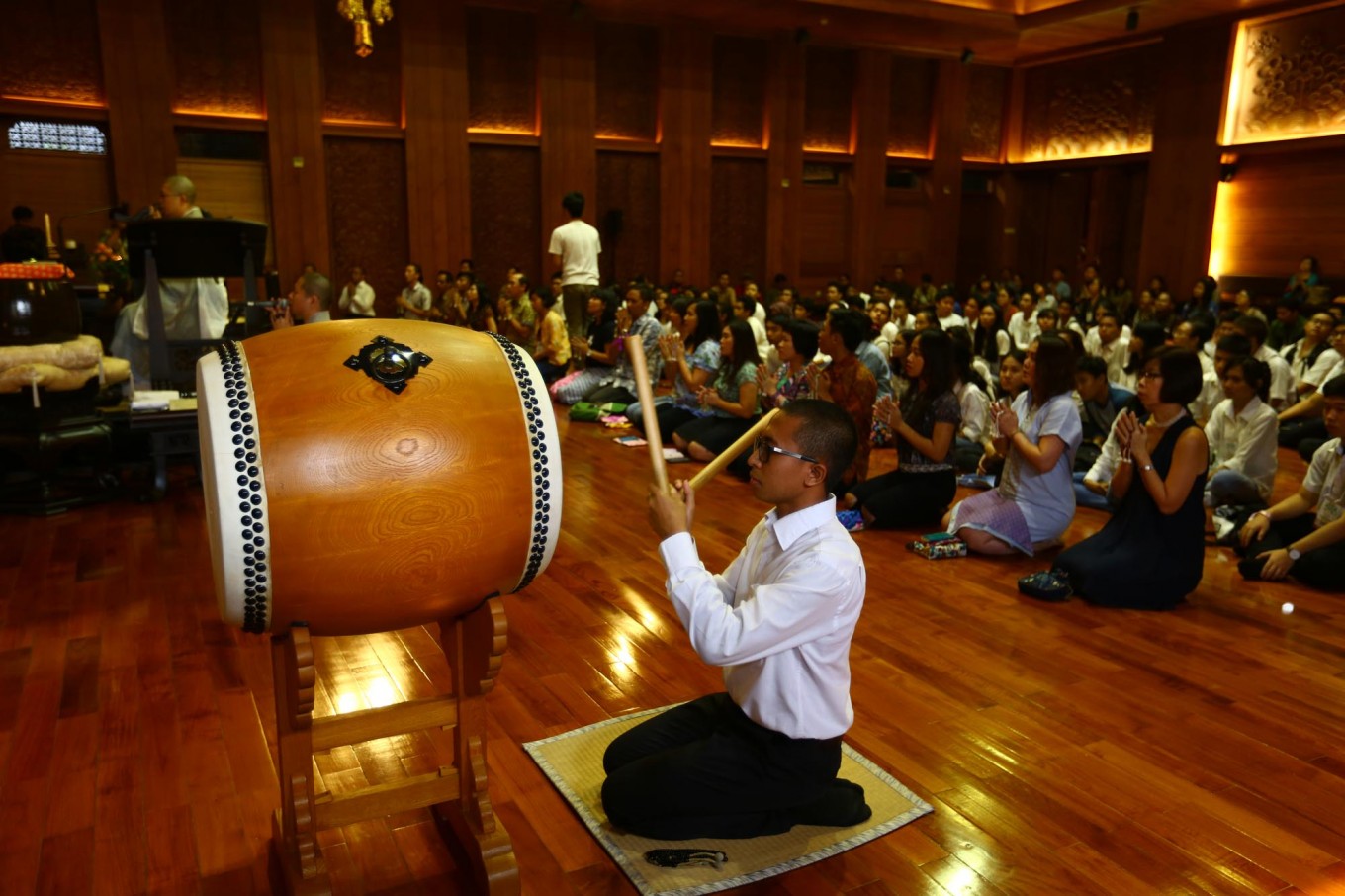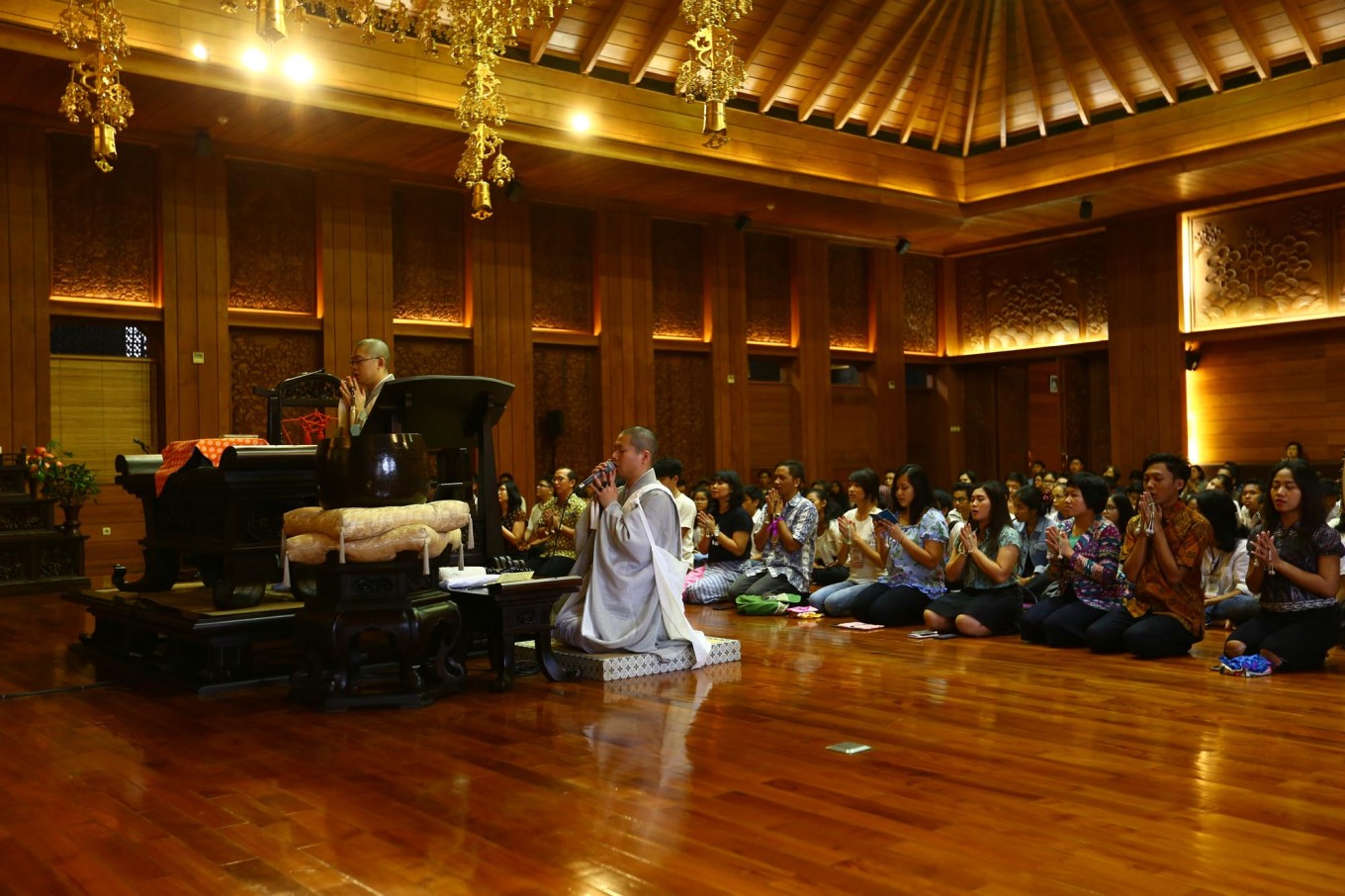Popular Reads
Top Results
Can't find what you're looking for?
View all search resultsPopular Reads
Top Results
Can't find what you're looking for?
View all search resultsFive places to go in Jakarta to observe religious diversity
Change text size
Gift Premium Articles
to Anyone
A
mid the rising intolerance that continues to fill news headlines and social media, an activity is being held to remind people about the religious diversity that Indonesia enjoys and, at the same time, show that Jakarta does not only offer a plethora of malls and cafes.
Dubbed "Wisata Rumah Ibadat" (Places of Worship Tourism), the activity invites participants to visit several places of worship in Jakarta to learn about tolerance and religious diversity. Held for the second time on Tuesday, it was joined by teenagers and kicked off at GPIB (Synod of Protestant Churches in Western Indonesia) Immanuel and ended at Pura Aditya Jaya Ramawangun.
In each place of worship, the participants received explanations about its history, the way people pray and the meaning of symbols or philosophies used in the various religions.
Below are the destinations scattered across Jakarta that one can consider visiting to learn more about religion in Indonesia:
 Participants explore the GPIB Immanuel, Central Jakarta. (JP/Wienda Parwitasari)
Participants explore the GPIB Immanuel, Central Jakarta. (JP/Wienda Parwitasari)
Situated in Gambir, Central Jakarta, GPIB Immanuel is one of the oldest churches in the city. Built in the 1830s and designed by Dutch architect J. H. Horst, the church used to be named "Willem Kerk", but was later changed in 1948 to "Immanuel" (God with Us).
As part of Jakarta’s cultural heritage, the church is known for its dome, which is able to reflect sound and was used for sermons in the past. The dome was designed in such a way that it transfers an equal amount of sunlight to the inner parts of the church. GPIB Immanuel also has an historic pipe organ that was made by J. Datz in 1843. The organ can still be played today.
The services at GPIB Immanuel are divided depending on which language is used; Bahasa Indonesia (6 a.m., 8 a.m. and 6:30 p.m.), Dutch (10 a.m.) and English (5 p.m.).
Address: Jl. Merdeka Timur No. 10, RT 2/RW 1, Gambir, Central Jakarta.
St. Mary of the Assumption Cathedral
 Teenagers and senior high school students explore the Jakarta Cathedral. (JP/Wienda Parwitasari)
Teenagers and senior high school students explore the Jakarta Cathedral. (JP/Wienda Parwitasari)
St. Mary of the Assumption Cathedral, popularly known as the Jakarta Cathedral, was officially established on April 21, 1901, but the original building was actually built in 1810. The church was designed in neo-gothic style and has three spires that are currently under renovation. Meanwhile, the ceiling is made from wood to anticipate earthquakes. On both sides of the church, people can view a series of paintings titled The Way of the Cross (Jalan Salib).
Jakarta Cathedral has daily and weekly mass schedules. It also has bells that are rung at 6 a.m., 12 p.m. and 6 p.m. to remind people to pray. Those who decide to visit this church must not pass the batas suci (sacred line) in front of the altar. The church also has special praying space and facilities for people with disabilities.
One of the activity participants, 18-year-old Amanda Najla, who is a student of an Islamic boarding school in East Java, said that getting insights from various sources about religions in Indonesia and their development really opened her eyes. “At school, we only learn about our religion, therefore we lack information about other religions. I will encourage other teenagers to join the activity; to see, learn and understand more about religious diversity in Indonesia,” she said.
Address: Jl. Katedral No. 7B, Pasar Baru, Sawah Besar, Central Jakarta.
Istiqlal Mosque
 Participants take a picture together at Istiqlal Mosque. (JP/Wienda Parwitasari)
Participants take a picture together at Istiqlal Mosque. (JP/Wienda Parwitasari)
Located right across from the Jakarta Cathedral, Istiqlal Mosque was built as a form of gratitude for Indonesia’s independence. Its name, which was derived from the Arabic language, literally means "Independence". At first the mosque was going to be built in the Hotel Indonesia traffic circle area, but at the suggestion of Indonesia's first president Soekarno, the mosque was constructed in its current location, which used to be known as Wilhelmina Park. In 1978, it was officially established by the country's second president Soeharto.
Known as the largest mosque in Southeast Asia, Istiqlal can accommodate up to 300,000 jama’ah (worshippers). The building only has one minaret, symbolizing the Muslim belief of one God. It also has a large dome up to 45 meters in diameter, while the smaller dome is 8 meters in diameter and the moon-star sculpture is 17 meters in height. When they are combined they form the date of Indonesia’s independence: Aug. 17, 1945.
Those who want to visit the mosque should wear appropriate clothes; do not wear shorts, tank tops or see-through clothing, although long kimonos are available to lend for foreign tourists. You also need to take off your shoes or sandals prior to entering the mosque.
Address: Jl. Taman Wijaya Kusuma, Pasar Baru, Sawah Besar, Central Jakarta.
Read also: Mandalika Grand Mosque to open before Idul Adha
Hoseiji Temple
 The inside of Hoseiji Temple.(JP/Wienda Parwitasari)
The inside of Hoseiji Temple.(JP/Wienda Parwitasari)
Hoseiji Temple (Kuil Hoseiji) was built in 2005. Its construction materials came from several provinces in Indonesia, included Bali and Central Java. The temple is the place of worship for Buddhists with Japan-based Nichiren Shoshu as its branch. Located in Manggarai, the Hoseiji Temple features a praying room, a classroom, reception and an office. The temple is open from 7 a.m. to 9 p.m.
Those who want to visit Hoseiji Temple should take off their shoes and sandals, then keep them in cabinets near the entrance. It is prohibited to take a photo of the sacred altar, especially when it is in an open position. Those who have questions regarding Buddhism and the temple can ask the receptionist at the left side of the entrance. You can also talk to one of the Bhikkus but only after making an appointment.
Address: Jl. Padang No. 27, RT 05/08, Pasar Manggis, Setiabudi, South Jakarta.
 Participants enjoy a Balinese dance performance at Pura Aditya Jaya, Rawamangun.(JP/Wienda Parwitasari)
Participants enjoy a Balinese dance performance at Pura Aditya Jaya, Rawamangun.(JP/Wienda Parwitasari)
Located in Rawamangun, East Jakarta, Pura Aditya Jaya (Aditya Jaya Temple) was officially established in May 1972, but the construction itself took eight phases from 1972 to 2006. The temple can be reached via its main gate (Candi Bentar) on Jl. Jenderal Ahmad Yani, but when it is closed, you are advised to go to Jl. Daksinapati Raya instead.
Adopting the Tri Mandala (three realms) structure, the pura consists of three parts, namely Nista Mandala that covers the parking area, Madya Mandala or the middle area that hosts the kitchen and Balai Wantilan (place for meeting or preparing for a religious ceremony), and Uttama Mandala, which is the most sacred area, where Hindu believers pray.
Women who want to visit Pura Aditya Jaya should not enter the Uttama Mandala when they are on their period. Aside from wearing modest clothing, visitors should also wear a sarong and senteng (scarf) around their waist and take off their shoes or sandals.
Address: Jl. Daksinapati Raya No. 10, Rawamangun, East Jakarta
Wisata Rumah Ibadat was initiated by two non-profit organizations, Bhinneka Community and Sekar Nusa Community, who are mostly concerned about diversity and culture in Indonesia. The activity is designed for youths and high school students to help them learn more about the reality of religious diversity in this country. The first installment of the activity was held in Bandung in May and was joined by elementary students. (kes)







